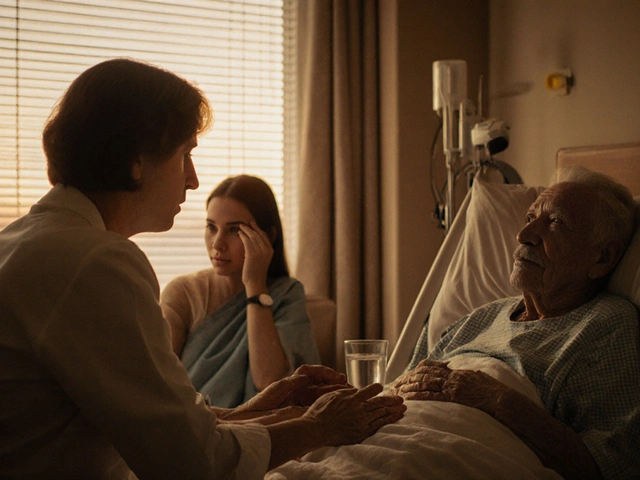How Palliative Massage Transforms Hospice Care: Benefits, Techniques, and Safety

TL;DR
- Gentle touch can lower pain, anxiety, and restlessness in hospice within minutes and often improves sleep and mood the same day.
- Use short, frequent sessions (5-15 minutes), feather-light pressure, and symptom-focused strokes; stop if breathing, face, or body tenses.
- Check safety first: fragile skin, bone mets, ports/lines, anticoagulants, low platelets, or suspected clots mean no deep work and sometimes no touch in that area.
- Track impact with simple 0-10 pain/anxiety scales before/after; adjust the plan weekly with the hospice nurse.
- Evidence is moderate for anxiety and short-term pain relief; it’s a comfort tool, not a cure. People often feel listened to and cared for, which matters.
When someone you love is dying, you want one thing: comfort that actually works. Gentle touch does that in a way meds alone can’t. It slows the body, eases fear, and softens pain-often fast. I’ve done this at a bedside while my Golden Retriever, Dexter, settled at our feet and my parrot, Loki, muttered from the hallway. The goal isn’t to fix everything. It’s to make this hour easier than the last, safely.
What palliative massage is (and how it actually helps)
Most people picture spa massage. Hospice is different. Here we use light, symptom-focused touch to reduce pain, anxiety, breathlessness, nausea, and loneliness. Think of it as comfort physiology: slow, predictable strokes tell the nervous system it’s safe. That flips the body from fight-or-flight to rest-and-digest, which can lower pain signals, calm the heart rate, and ease panic.
What the research says: the National Center for Complementary and Integrative Health (NIH/NCCIH, 2024) reports massage can reduce short-term pain and anxiety in many conditions. A Supportive Care in Cancer meta-analysis (2023) found small-to-moderate reductions in pain and anxiety for people with cancer when gentle massage was added to usual care. A JAMA randomized trial in advanced cancer (2008) found both massage and simple touch reduced distress during the session; people rated massage more satisfying. In hospice, even a five-minute hand or foot session can quiet the room.
Set the right expectations. Benefits are usually immediate but time-limited (minutes to hours). The point isn’t to replace meds; it’s to layer comfort. Families often report better sleep the night of a session. Nurses notice smoother breathing and fewer agitation spikes.
What it is not: deep tissue, aggressive stretching, or anything that risks fragile skin or bones. Most sessions are done in bed or a recliner, clothed, with minimal lotion, and frequent check-ins.
Key outcomes you can aim for today:
- Lower pain by 1-3 points on a 0-10 scale
- Reduce visible anxiety (jaw, shoulders, hands relax) within 5-10 minutes
- Smoother breathing and less restlessness during and after the session
- More connection-silent reassurance is a big part of the medicine
Step-by-step: adding gentle touch to a hospice plan (safely)
Here’s a simple, repeatable way to bring palliative massage into daily care without guesswork.
Check safety and timing
- Ask the hospice nurse: Any clot risk, new swelling, fever, skin tears, bone mets, infection precautions, lines/tubes, platelet count, anticoagulants?
- Good times: before bedtime, after bathing, during anxiety spikes, or ahead of a painful care task (turning, wound care).
Get consent and set goals
- Even with confusion or dementia, ask: “May I hold your hand and rub gently for comfort?” Watch face, hands, and breath for yes/no cues.
- Pick one goal: pain, anxiety, breathlessness, or sleep. Narrow focus works better.
Prepare the space
- Reduce noise and bright light. Warm the room. Clean hands. Use a tiny dab of neutral lotion if skin is dry.
- Position for comfort: pillows under knees or elbows, head slightly raised if short of breath.
Choose the right technique
- Pain: slow, flat hand strokes around-not across-painful spots; long effleurage on limbs; gentle holds at joints.
- Anxiety: hand/foot cradling, slow thumb circles on palms/soles, temple and scalp strokes.
- Breathlessness: synchronized back or shoulder strokes to the person’s exhale; keep pace with their breathing.
Use the “2-out-of-10” pressure rule
- On a scale where 0 is feather-light and 10 is deep tissue, stay at 1-2. If you see a wince or breath catch, lighten up or stop.
Keep it short and frequent
- Start with 5 minutes. If it’s helping, go to 10-15 minutes. Many shorter sessions beat one long marathon.
Close gently
- End with still hands for three breaths. Tuck blankets, thank them, and let the room stay quiet for a minute.
Measure and adjust
- Ask for a pain or anxiety number before/after. If speech is hard, score by cues: face, hands, breath, and restlessness.
- Report changes to the hospice nurse. Update meds and touch plan together.
Caregiver-friendly 10-minute routine (template):
- Minute 0-1: Ask consent; warm hands; set one goal.
- Minute 1-4: Hand cradle with slow thumb circles in the palm; 6-8 slow passes per minute.
- Minute 4-7: Forearm strokes from wrist to elbow, then back down, light and steady.
- Minute 7-9: Shoulder and upper back flat-hand strokes, matched to their breathing.
- Minute 9-10: Still hands; whisper thanks; cover and pause.
I keep two rules in my pocket: “Never chase the pain with pressure” and “If the breath tightens, the hands lighten or stop.” Those alone prevent most problems.
Techniques by symptom, with what the evidence supports
Different symptoms respond to different kinds of touch. Use this as a menu, not a script.
- Pain (muscle/joint): long, slow strokes on nearby muscles; gentle joint holds; avoid pressing directly on tumors or fragile areas. Look for warm hands, slower breathing, and a softer jaw as yes-signs.
- Anxiety/restlessness: hand/foot work, scalp and temple strokes, still-touch holds. Soothing rhythm matters more than where you touch.
- Breathlessness: back or shoulder strokes timed to exhale; slow and light. If breathing worsens, stop and reposition.
- Nausea: cool cloth on forehead; slow circular strokes on shoulders and hands; never push on the belly unless a clinician okays it.
- Neuropathy: ultra-light wrapping strokes; no rubbing hard on numb or burning areas.
- Edema/lymphedema: feather-light strokes sweeping toward the torso; skip if there’s infection, heat, or sudden swelling-call the nurse.
| Goal/Symptom | Technique | Pressure | Duration | Evidence signal | Who can do it |
|---|---|---|---|---|---|
| Pain (general) | Slow limb effleurage; joint holds near painful area | 1-2/10 | 5-15 min | Small-moderate short-term reduction (Supportive Care in Cancer, 2023; NCCIH, 2024) | Caregiver or therapist |
| Anxiety | Hand/foot cradle; temple/scalp strokes | Feather-light | 5-10 min | Consistent session-time calming (JAMA, 2008; hospice studies 2019-2022) | Caregiver or therapist |
| Breathlessness | Back/shoulder strokes synced to exhale | Very light | 3-8 min | Physiologic calming; limited trials but promising bedside reports | Caregiver with nurse guidance |
| Nausea | Cool compress; shoulder/hand strokes | Feather-light | 3-5 min | Symptom relief reported in palliative case series | Caregiver |
| Agitation at night | Foot strokes; still-touch holds | 1/10 | 5-10 min | Better sleep the same night in hospice audits | Caregiver or therapist |
Citations you can trust: NCCIH (NIH, 2024) on massage for pain/anxiety; Cochrane Review on massage in cancer (2016) noting low-to-moderate quality but meaningful session-time relief; ASCO guidance on integrative approaches to cancer pain (2022) supporting massage as an adjunct; pragmatic hospice studies in BMJ Supportive & Palliative Care (2019-2021) showing reduced anxiety with hand/foot massage.
Two quick case snapshots:
- Advanced lung disease with panic spikes: 3-minute shoulder strokes matched to exhale cut visible panic within two minutes; oxygen saturation steadied from 90% to 94%. Nurse kept the technique before nebulizer sessions.
- Metastatic bone pain in hip: no pressure on the hip; instead, long calf and foot strokes plus gentle knee holds. Pain dropped from 7 to 4 for about three hours-enough to nap before visitors.

Safety first: red flags, pressure rules, and what to avoid
Touch is medicine. Dose it right and avoid the landmines.
Absolute stop signs (call the nurse before touching):
- Possible clot (new one-sided swelling, heat, redness in a limb)
- Unexplained severe pain or new neurological changes
- Skin infection, open wound not covered, or new rash
- Active radiation burn areas or recent procedures not cleared by the team
High-caution situations (modify or skip the area):
- Bone metastases or severe osteoporosis: no pressure on ribs, hips, spine; use nearby comforting holds only.
- Anticoagulants or low platelets: keep pressure feather-light. Many oncology massage guidelines use a platelet caution threshold near 50,000/µL; defer deeper work well above that.
- Lines, ports, ostomies, drains: no strokes over or traction near devices.
- Lymphedema: ultra-light, direction-aware strokes; skip if there’s fever, heat, or sudden swelling.
- Neuropathy or allodynia: touch may feel painful; use still-touch holds or wrap-style contact rather than rubbing.
Cleanliness and products:
- Wash or sanitize hands before and after. Short nails, no jewelry.
- Use unscented lotion if skin is dry. Strong fragrances can trigger nausea or headache.
- Aromatherapy is optional; avoid diffusers in breathlessness or when oxygen is running unless the team approves.
How to set pressure without guessing:
- Ask: “Is this pleasant, too much, or too little?” Recheck every minute early on.
- Watch the breath. If it holds or speeds up, you’re too deep.
- Look at the hands and jaw. If they tense, back off or stop.
Who should provide it:
- Family and aides can safely give short, light comfort sessions with nurse guidance.
- Licensed therapists trained in oncology or hospice work are best for complex cases (bone mets, lymphedema, severe pain).
Coverage and cost basics (2025):
- Hospice agencies often include complementary therapies when available; ask your team what’s offered.
- Medicare hospice benefit doesn’t guarantee massage, but many nonprofits fund it. Some insurers reimburse when billed under palliative programs.
- When paying privately, shorter bedside sessions (20-30 minutes) are common and more affordable. Ask for a hospice rate.
Professional guidance and standards to look for: oncology massage training, familiarity with platelet/anticoagulant precautions, and willingness to coordinate with the hospice team. Ask, “How do you modify for bone metastasis or low platelets?” A good provider has a clear answer.
Tools you can use today: checklists, decision aids, and quick scripts
Session setup checklist (one page in your care binder):
- Goal chosen (pain, anxiety, breath, sleep)
- Safety checked (clots, lines, fragile areas, platelets if relevant)
- Space set (quiet, warm, soft light)
- Consent gathered (verbal or visible yes-cues)
- Pressure plan (1-2/10) and stop signal agreed
- Lotion ready (unscented) and tissues/warm towel
- Pre-session score (0-10) for pain/anxiety
- Post-session score and notes for the nurse
Three golden rules:
- Go slow enough to match their breathing.
- Stay lighter than you think. If you’re unsure, lighten more.
- Stop the moment it looks or feels wrong.
Simple decision tree (text version):
- If the person seems restless or anxious → Start with hand cradle. Calmer in 2 minutes? Continue. If not, switch to foot strokes. Still no? Pause and try music or guided breathing.
- If pain is focal (e.g., hip) → Avoid the spot. Work around it (calf/foot, shoulder). If pain eases by 1-2 points, you’re on track. If pain rises, stop and alert the nurse.
- If breath is tight → Back/shoulder strokes timed to exhale. If breathing smooths within a minute, continue up to 5 minutes, then rest.
Caregiver scripts that work:
- Consent: “Would it be okay if I held your hand and rubbed gently to help you relax?”
- Checking in: “Is this pleasant, or should I go lighter?”
- Closing: “I’ll leave my hands here for three breaths, then let you rest.”
Measuring what matters (fast):
- Before/after 0-10 ratings for pain or anxiety; if speech is hard, note signs: facial tension, hand clenching, restlessness, breath rate.
- Track sleep: Did they nap or sleep longer after sessions?
- Share a one-line update with the team: “10-minute hand and foot session dropped anxiety from 6 to 3; slept 90 minutes.”
Mini-FAQ
- How often should we do this? Short, daily sessions work best. Even 3-5 minutes before bed can help.
- What if they’re unresponsive? Still-touch holds can comfort without stimulation: one hand on the shoulder, one on the forearm, slow and steady.
- Can touch trigger pain flares? Yes, if pressure is too deep or if you work over injuries. Keep it feather-light and skip problem areas.
- Does massage interfere with meds or oxygen? No. It often complements them. Time sessions between meds if drowsiness is heavy, or use still-touch if they’re very sleepy.
- Should we use oils? Unscented lotion is safest. Strong scents can bother nausea or breath.
Pitfalls to avoid:
- Rushing. Fast strokes arouse instead of calm.
- Pressing on edema, ports, or painful tumors.
- Skipping consent. Even a nod or relaxed hand squeeze counts; a grimace means pause.
Quick add-ons that amplify results:
- Breathing cue: “In through the nose, sigh out through the mouth.” Match your strokes to their exhale.
- Temperature: Warm hands and a soft blanket calm the nervous system more than you’d think.
- Sound: Quiet room or soft instrumental music at low volume. Voices low and slow.
Next steps and troubleshooting by role
For family caregivers:
- Start tonight with a 5-minute hand routine. Log a before/after anxiety number.
- Bring your log to the nurse visit. Ask for coaching on pressure and areas to avoid.
- If you meet resistance, offer choice: “Hand or foot?” Autonomy matters.
For hospice nurses and aides:
- Teach the 2-out-of-10 pressure rule and breath-matched pacing in your next visit.
- Add a checkbox to your flowsheet: “Comfort touch offered? Yes/No. Response?”
- Flag high-risk patients for therapist referral (bone mets, platelets under threshold, new edema).
For patients:
- Say what you want: “Please rub my hands very lightly” or “Only scalp today.” Your words guide the dose.
- Use a stop word (“Pause”) if anything feels off, even slightly.
Common roadblocks and fixes:
- They say, “Don’t touch me.” Respect it. Offer still presence or try again later with a different area (scalp or foot) and ask permission again.
- Skin is too fragile. Switch to still-touch holds over clothing, or place hands over a blanket.
- Severe breathlessness. Prioritize positioning and meds first; then add 2-3 minutes of breath-synced shoulder strokes if tolerated.
- No time. Use micro-sessions: 60 seconds of temple strokes before turning; still-touch for three breaths after care tasks.
How to choose a therapist (if available):
- Ask about oncology/hospice training and how they modify for bone mets, ports, and anticoagulants.
- Request shorter bedside sessions and coordinate with medication timing.
- Ask your hospice social worker about grants or volunteer programs.
Why this works beyond the skin: slow, predictable touch engages C-tactile fibers that signal safety to the brain. That’s why even feather-light contact can drop heart rate and ease pain. In hospice, that kind of safety is the point. I’ve seen a clenched jaw soften in under a minute and a hard night turn into real sleep-while Dexter thumped his tail once, as if to say, “Good job, human.”
Key sources to mention in your next team huddle: NCCIH (NIH, 2024) summary on massage for pain and anxiety; Cochrane Review on massage in cancer (2016); ASCO integrative pain guidance (2022); hospice-focused studies in BMJ Supportive & Palliative Care (2019-2021). Use them to back your request for comfort touch resources or a therapist referral.
If you remember only three things: keep it light, go slow, and let the person lead. Comfort comes fast when you do.





